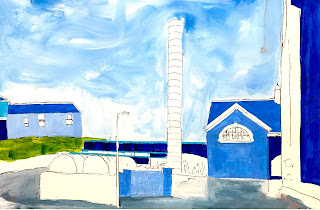I stop by them in the car, photograph and draw them. Later paint them. Drawn to them with “the sort of compulsion that derives from their physicality rather than any associations”1.
Their meanness and implied indigence is prominent. Many are heartening neglected, ugly.
These are small scale scrawled marks on the landscape. Satisfying and enduring, preserved for function or former utility.
 |
Another drive by painting: Llanygnog |
Their composition is stone, breeze block, rusting corrugated tin.
Some have modern olive green steel roofs, a concession to trying to blend in. Windows without glass slowly shedding their paint.
Close by an obligatory shipping container is pressed into service for who knows what.
 |
On the road to St Clears: Sheds nestle next to a caravan |
Dereliction in these parts means two of most things, at least: cars up on bricks, corrugated sheets, plastic buckets, wire, fencing posts, tyres (lots of). Close by half a car, three-quarters of a car, a shed a hutch, more posts. All subdued by grass, ivy, creepers and old man's beard.
Oil drums (colours various) and the nearby gate is secured by blue bailer twine, acting as both hinge and latch.
Colour has a vital part to play in this agricultural tableaux.
Every shade of grey you could mix,
for the stone, concrete and skies overhead.
Add Burnt Sienna for the rust,
Turquoise or electric blue in the plastic detritus that on the ground in front.
Lemon Yellow (hose pipes)
Cadmium Orange (baler twine).
Lichen: shades from dark Hookers Green to the palest blue or a watery mustard yellow.
 |
| Late December Afternoon - Brook Farm nr. Pendine |
Trashtische?
These buildings and their grounds are visually pungent. More satisfying than the mollycoddled rural museum heritage-experience with entry fees and overgrown with signage.
1 Jonathan Meades from Pedro and Ricky Come Again Unbound Books 2021
.






























.JPG)












